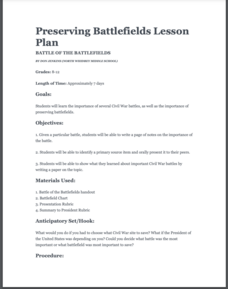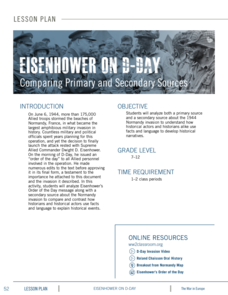Center for History Education
Who Fired the Shot Heard Round the World?
Take a closer look. Young academics become detectives in an engaging lesson on the American Revolution. Scholars work in groups to analyze documents to uncover whether the American colonists or British soldiers fired the first shot at...
Weebly
Liberty Theme Park Project
Invite your young historians to demonstrate how the American Revolution truly was one crazy ride after another as they design a theme park! This unique and engaging project prompts learners to consider major events leading up to and...
American Battlefield Trust
Preserving Battlefields
Save that site! Budding historians go on a rescue mission to save important Civil War battle sites using a project-based lesson. After carefully researching the importance of critical engagements and evaluating current threats, learners...
Curated OER
Iraq's Latest Strategy: Suicide Attacks
This discussion based lesson focuses on the sensitive topic of suicide attacks or bombings used throughout history during times of militaristic upheaval. Learners read news stories, compose journal entries, and engage in a class...
Curated OER
South Koreans in the Vietnam War
Young scholars consider why South Koreans fought in the Vietnam War. In this Vietnam War lesson, high schoolers engage in an activity through which they investigate why South Koreans fought in the Vietnam War and how their participation...
PBS
An Attack on Syria- What Would You Do?
Has United States military intervention in the conflicts of other countries always been warranted? After reviewing a brief background on contemporary US conflicts and reading articles describing the civil war in Syria, your learners...
Carolina K-12
The Twenty-Sixth Amendment and the Power of Youth
Empower teenagers to take political matters into their own hands! After completing an engaging warm-up activity, class members discuss both sides of the youth voting issue, learn about the connection between military history and the...
Mountain Secondary Library
World War I Poster Project
These three worksheets will help get your World War I propaganda poster project well on its way! It offers sample images of various types of propaganda topics, such as buying victory bonds or joining military forces. It then provides a...
iCivics
Responsibility Launcher
So how would pupils solve a town's problems? Using a video game, scholars tell residents of a town how to solve their problems by taking steps such as going back to school, voting, or serving in the military. As they make good choices,...
DocsTeach
WWI Propaganda and Art
Uncle Sam wants you! During World War II, the US government and military created a propaganda campaign to gain public support. The activity uses primary documents such as photos to explain how and why the propaganda campaign was...
DocsTeach
WWI America: Babe Ruth's Draft Card
Even the Great Bambino wasn't above suspicion during World War I. An eye-opening activity explores America's greatest pastime through the lens of government officials during WWI. Academics examine Babe Ruth's draft card to understand how...
Curated OER
Unsung Military Heroes
In this lesson, students are introduced to the contributions made by African-American soldiers that have been excluded from traditional textbooks. To gain an appreciation for these unsung heroes, students engage in research to ultimately...
Curated OER
Military Strategy: Powell Doctrine
Learners examine the life of Colin Powell and analyze several quotes regarding his military strategy. They discuss the ways in which his ideas have been implemented in current military policy.
Stanford University
Siege of Golconda
Looking at art, learners explore the Mughal Empire, which once controlled all of India and created a unique Hindu-Muslim civilization. By analyzing a painting of the Siege of Golconda, historians consider what art teaches people about...
Clark County School District
Hollywood's Take on the Cuban Missile Crisis: Thirteen Days
Watching the film Thirteen Days is an engaging way of acquainting learners with the Cuban missile crisis, and this learning exercise is the perfect accompaniment for viewership! It includes 15 questions for your young historians to...
Curated OER
Getting Help: Food Stamps and Nutrition Programs
Here is another lesson regarding the law. This time, the laws that dictate eligibility for food stamps is the focus. After an initial discussion about the basics of the laws, learners do a case study of a family who is applying for food...
Curated OER
Navajo Code Talkers
An engaging lesson focuses on the contributions of the Navajo people during World War II. Learners read the book Navajo Code Talkers by Andrew Santella, answer a series of comprehension questions about the text, and write a letter as a...
Friends of Fort McHenry
Citizens For and Against the War of 1812
Use this exceptional resource to examine the discourse and debate that occurred at the start of the War of 1812 with your class. Learners will first consider their own position on the war in a silent journal writing activity. Then after...
National Endowment for the Humanities
The War in the South, 1778–1781
The second in a three-part look at the Revolutionary War focuses the years from 1778 through 1781 and zooms in on military operations in the southern colonies, the French alliance, and the role African-Americans played in events. Class...
US Department of Veterans Affairs
Veterans Day
Teaching class members all about the importance and meaning behind Veterans Day with an informative resource. Pupils complete a classroom activity guide and individual research to learn more about the brave men and women who defend the...
National WWII Museum
Evaluating the US Decision to Drop the Atomic Bombs
While the use of the atomic bomb was the definitive end of World War II, the terrible weapons left new questions. Young scholars use primary sources and analytical worksheets to consider the implications of the fateful decision. Then,...
National WWII Museum
Eisenhower on D-Day: Comparing Primary and Secondary Sources
Dwight D. Eisenhower's message to troops for D-Day is iconic. Individuals examine Eisenhower's words and compare that to historians' understanding of the epic events of that day using primary sources, an essay, and a Venn diagram to...
National Endowment for the Humanities
The Gulf of Tonkin Resolution and Escalation of the Vietnam War
The Gulf of Tonkin Resolution propelled America's involvement into a bloody conflict—and it was based on a fallacy. Using the resolution and other documents from the Vietnam War, including declassified documents, young historians...
Curated OER
Turning the Tide in the Pacific, 1941-1943
Students analyze the Japanese strategy for the Pacific and compare it to the Allied strategy. They identify on a map the sites that were important the early war in the Pacific, and identify key military engagements.

























